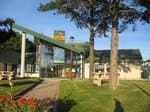Notre Dame de Grace
From the village of Saint-Izaire, reach the opposite bank and ascend to Notre-Dame-de-Grâce, a restored medieval shrine that overlooks the Dourdou plain. A carved standing stone and the native home of Canon Hermet who was an expert on the subject, delineate this heritage loop which also follows an old railway.
3 points of interest
 History and heritage
History and heritageVillage of Saint-Izaire
The history of this village is intertwined with that of the old Episcopalian castle, which was formerly the Bishop of Vabres summer palace. The name of the village was first made mention of in an official document dating back to 862 AD.
During the 12th century, continual invasions, acts of banditry and battles between feudal lords created a tremendous insecurity. This led to the building of battlements to improve the defensive system and providea safe haven to the neighbouring people during periods of turmoil. The castle and the fortified village date back to the time of the Vabres bishops who made the village their summer residence and a safe refuge.
When the religious wars were over and peace restored, the protective wall lost its primary function and so today the façade of the castle has windows inserted along its length. The fortified gates were also demolished to allow the passage of carts or to expand the neighbouring houses. The villagestreet, footpath and house pattern has remained unchanged since the Middle Ages, and the beautiful 15th century facades and windowscan still be seen in some streets today. The old church part of the battlements had its vault lowered in 1635 to provide housing to the schoolmaster and guards. In 1650 repair works were started by the Consuls.
 History and heritage
History and heritageNotre Dame de Grâce chapel
This sanctuary which was founded by Alix de Castelnau has existed since at least the 15th century, when it was called Ouradou (oratory). This chapel was refurbished in 1730 and during the 19th century, the stairway door of the castle was then brought back into use.
 Archeology
ArcheologyCarved standing stone of the Mas Capelier (B) This statue displays all of the feminine feature
This statue displays all of the feminine features: breasts are depicted either side of the Y shaped pendant,legs are set apart and the hair is tied back and depicted by a stripe down the back from the top of the head to the belt. The eyes are wide open set either side of the nose above tattooed cheeks represented by four lines.
Description
- The starting point is the Place de la Bascule (carpark under the bridge), cross the bridge.
- At the roundabout take to the left towards Broquiès. After approximately 50 m, head directly to the almost only tricky part of this walking route: a 100 m long steep path that leads to the foot of ND de Grâces Chapel. At the rear of the chapel, you will find a small enclosed area to relax and enjoy a scenic view over the village and the plain. A pilgrimage, well known in the region, takes place every year (nowadays, on August 15th) with an open air mass which is celebrated in the enclosed area.
- Carry on to the left towards the former hôtel Bellevue, leave the tarred road to ascend straight on the path called « chemin du château d’eau ».
- Keep walking until you reach a carved standing stone to the right, a notice board displays the history of the statue. Then, carefully follow the marking signs, for here several tracks head in all directions. The one which is to be followed is the most to the right, it is narrow, uneven, runs downhill and goes back to the Dourdou plain.
- Next, follow to the right the ancient railway until you reach a junction again on the right that rises to the chapel. Enjoy once more the view over the plain.
- Then retrace your way back to the starting point.
- Departure : Place de la Bascule, Saint-Izaire (carpark under the bridge)
- Arrival : Place de la Bascule, Saint-Izaire (carpark under the bridge)
- Towns crossed : Saint-Izaire and Calmels-et-le-Viala
Altimetric profile
Recommandations
Box tree months are active from May to October. During the caterpillar phase, they feed on the leaves of box trees. They crawl down trees and move on long silken threads, although these threads are annoying when hiking they do not pose any health risk
Information desks
Avenue de Lauras, 12250 Roquefort/Soulzon
Situated in the Grands Causses Regional Natural Park, the cheese village of Roquefort stretches on the hillside over the famous scree of the Combalou Rock, in southern Larzac. The village is at an elevation of 630 m and has 700 inhabitants.
OPENING PERIODS:
The Tourist Office is open all year round:
- In July and August, Monday to Saturday: 9.30 to 18.30, Sunday: 10.00 to 17.00.
- April, May, June, September, October; Monday to Saturday: 9.30 to 12.15 & 13.00 to 17.30, closed on Sunday.
- January, February, November, December; Monday to Friday: 9.30 to 12.15 & 13.00 to 17.00, closed on Saturday and Sunday.
Transport
Travel by bus or train: https://lio.laregion.fr/
Carpooling : BlaBlaCar, Rézo Pouce, Mobicoop, Idvroom, LaRoueVerte, Roulez malin
Access and parking
From Millau, follow the D992, then the D999 up to Vabres l’Abbaye, from Albi, follow the D999 up to Vabres l’Abbaye. Once in the village, proceed to the West via the D25. Saint-Izaire is located 16 km from Vabres l’Abbaye.
Parking :
Report a problem or an error
If you have found an error on this page or if you have noticed any problems during your hike, please report them to us here:
